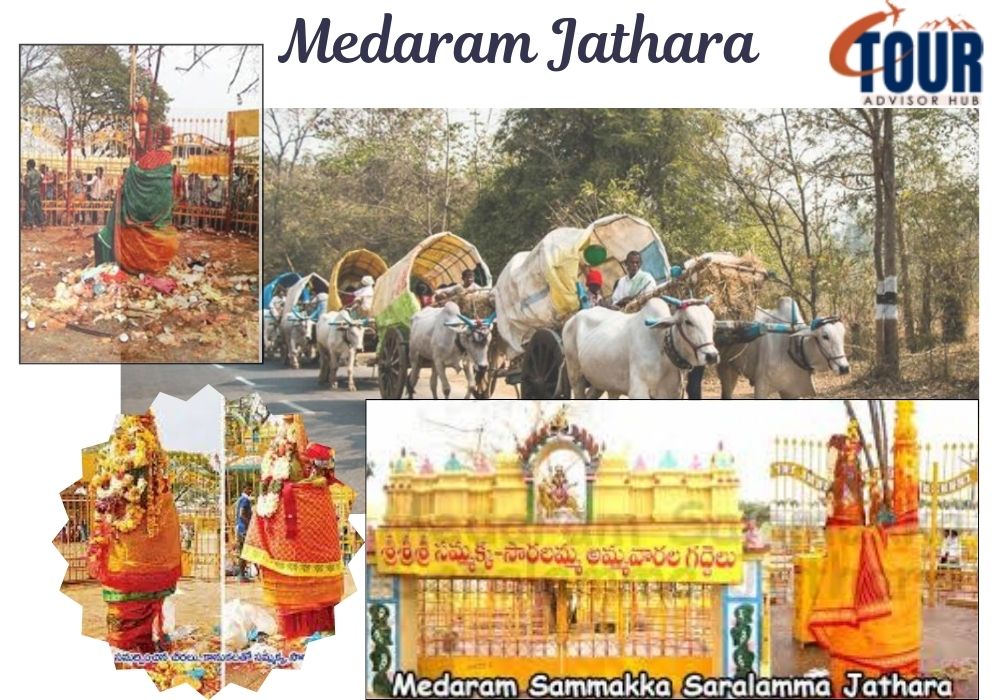Introduction
Medaram Jatara, also known as Sammakka Saralamma Jatara, is one of the largest tribal festivals in India, and it is celebrated in the state of Telangana. It is a biennial festival dedicated to the tribal goddesses Sammakka and Saralamma, drawing millions of devotees. The event is an integral part of the tribal heritage and spiritual beliefs, showcasing the rich traditions of the Koya tribe.
Historical Background
The origins of Medaram Jatara date back several centuries. The festival is believed to commemorate the brave sacrifice of Sammakka, a tribal woman who fought against the Kakatiya dynasty to protect her people. Legend has it that Sammakka, along with her daughter Saralamma, resisted the unjust taxation imposed on the tribal community. Despite her valor, she mysteriously disappeared into the forest, and it is said that she transformed into a divine force, becoming a deity worshipped by generations.
When and Where is Medaram Jatara Celebrated?
Medaram Jatara takes place once every two years (biennially) during Magha Masam (January-February) in the village of Medaram, located in the Mulugu district of Telangana. The festival spans four days and coincides with the full moon. The main celebrations occur at the Sammakka Saralamma temple, a sacred site in the dense forests of Medaram.
Rituals and Key Events of Medaram Jatara
The festival follows a series of elaborate rituals, with each day holding a unique significance:
Day 1: Arrival of Saralamma
On the first day, the idol of Saralamma, daughter of Sammakka, is brought from Kannepalli village to Medaram amidst chants, drum beats, and traditional dance. This marks the festival’s beginning as devotees gather in large numbers.
Day 2: Arrival of Sammakka
The second day witnesses the most significant event—the arrival of Sammakka’s idol from the Chilakala Gutta hill. The event is highly spiritual, and lakhs of devotees await the divine presence of their goddess. The procession is accompanied by rituals performed by tribal priests (Koya Doras).
Day 3: Offering of Jaggery and Prayers
On the third day, devotees offer jaggery, turmeric, vermilion, and coconuts as a symbolic gesture of devotion. Jaggery, often referred to as “Bangaram” (gold), is considered a sacred offering. The devotees believe that their wishes will be fulfilled if they pray sincerely.
Day 4: Farewell to the Deities
On the final day, the goddesses are taken back to their respective locations, and devotees bid farewell with immense reverence. Many believe that the deities’ presence purifies them and ensures prosperity for the upcoming years.
Jampanna Vagu: The Sacred Stream
Jampanna Vagu, a significant part of Medaram Jatara, is a stream that holds immense spiritual importance. According to legend, Jampanna, the brave son of Sammakka, fought valiantly against the Kakatiya forces but was ultimately martyred in the battle. The stream is believed to have turned red with his blood, symbolizing his sacrifice. Even today, devotees take a holy dip in Jampanna Vagu, believing that it cleanses them of sins and grants them divine blessings. The stream is a crucial pilgrimage spot, and the government ensures its maintenance during the festival to accommodate the massive influx of devotees.
The Spiritual and Cultural Significance
Medaram Jatara is not just a religious festival but also a cultural extravaganza. It represents the deep spiritual beliefs of the tribal communities, particularly the Koya tribe. The festival upholds the values of sacrifice, unity, and devotion.
One of the unique aspects of Medaram Jatara is that it is conducted without the involvement of Brahmin priests, unlike many other Hindu festivals. Instead, the rituals are performed by the Koya tribal priests, following their traditional customs.
The Magnitude of the Festival: A Gathering of Millions
Medaram Jatara is considered one of the largest tribal congregations in the world. The number of devotees attending the festival has been steadily increasing over the years, with estimates ranging from 10 to 15 million people in recent celebrations. The massive turnout makes it the second-largest religious gathering in India after the Kumbh Mela.
Government Arrangements and Infrastructure Development
Given the massive influx of pilgrims, the Telangana government takes extensive measures to manage transportation, medical services, water supply, and security. Roads leading to Medaram are upgraded, and special buses and temporary accommodations are arranged for devotees. The festival also generates significant revenue for local vendors, boosting the regional economy.
Tribal Identity and Environmental Conservation
Medaram Jatara is a festival deeply connected to nature and the tribal way of life. The deities are represented in natural forms, such as bamboo sticks or symbolic idols, rather than conventional sculpted statues. The entire celebration occurs in a natural setting, reinforcing the bond between the tribal community and their environment.
However, the large congregation also poses environmental challenges. Waste management and deforestation have become concerns, prompting the government and NGOs to implement eco-friendly measures such as plastic bans and waste recycling initiatives.
Medaram Jatara and Its Impact on Tourism
The festival attracts not only devotees but also tourists, anthropologists, and researchers interested in studying tribal traditions. The unique customs, music, and dance performances during the Jatara offer a rich cultural experience.
Many international travelers and scholars visit Medaram to understand indigenous rituals, making it a global phenomenon in terms of cultural tourism.
The Role of Women in Medaram Jatara
Women play a significant role in the festival, both as devotees and as leaders of rituals. Sammakka and Saralamma themselves are symbols of feminine power and resistance, inspiring women to stand for justice and empowerment. The festival highlights the strength and resilience of women in tribal society.
Challenges Faced by Medaram Jatara
Despite its grandeur, Medaram Jatara faces several challenges:
- Overcrowding: Managing millions of devotees in a remote location is a logistical challenge.
- Environmental Degradation: Deforestation, waste disposal, and water pollution are growing concerns.
- Commercialization: While the festival remains rooted in tribal traditions, increasing commercialization threatens its authenticity.
- Infrastructure Limitations: Temporary arrangements often fall short of accommodating the massive crowd.
Efforts are being made to balance traditional values with modern infrastructure to ensure the sustainability of the festival.
If you’re visiting Medaram, here are some nearby places to explore:
1. Tadvai Forest & Tadvai Caves (15 km)
- It is a beautiful forest area with caves and trekking opportunities.
- Ideal for nature lovers and adventure seekers.
2. Bogatha Waterfall (30 km)
- Known as the “Niagara of Telangana,” this scenic waterfall is a must-visit.
- Best visited during monsoon for full water flow.
3. Laknavaram Lake (75 km)
- A serene lake surrounded by lush greenery with a hanging bridge.
- Boating and scenic views make it a great picnic spot.
4. Eturnagaram Wildlife Sanctuary (20 km)
- One of Telangana’s oldest wildlife sanctuaries.
- Home to tigers, leopards, and deer, making it ideal for wildlife enthusiasts.
5. Ramappa Temple (100 km) (UNESCO World Heritage Site)
- A 13th-century ramappa temple with intricate carvings was built during the Kakatiya dynasty.
- A must-visit for history and architecture lovers.
6. Kaleshwaram Temple (95 km)
- The famous Shiva temple is located on the confluence of Godavari and Pranahita rivers.
- It is considered a sacred place for religious rituals.
Conclusion
Medaram Jatara is more than just a festival; it is a grand celebration of faith, culture, and history. It serves as a reminder of the rich tribal heritage of India and the spirit of devotion that unites millions. With increasing global recognition, Medaram Jatara continues to shine as one of the most significant spiritual events in the world.
Whether one visits as a devotee, a cultural enthusiast, or a traveler, the experience of Medaram Jathara is truly unparalleled—a testament to the enduring legacy of Sammakka and Saralamma, and the vibrant traditions of the tribal communities of Telangana.


